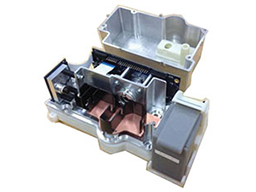A classical beam detector that hospitals, campuses, museums and other open areas would typically use for smoke detection uses two units, called a transmitter and a receiver. Inside the transmitter a light source (typically an infra-red LED) flashes periodically. Light from the LED is focused into a tight beam by a lens, and a finely adjustable mechanism is provided to allow the beam to be directed from where the transmitter is mounted at one end of a room towards the receiver or reflector(s) at the other end, which could be as far as 492 feet away.
However, traditional beam detectors often have issues with proper alignment and are prone to false alarms. Such false alarms may be triggered by, for example, objects such as banners, balloons or even birds entering the beam path, dust in the air or insects such as moths crawling on the optical surfaces of the transmitter, receiver or reflector. Once the beam is broken, as it would be by smoke in the event of a fire, the alarm is set off and the buildings normal safety and security measures have to be followed.
Open-area smoke detection systems, OSID, measures the extinction along a light beam caused by smoke particles along the direct path of the light beam, just like a traditional projected beam smoke detector, except that by using dual wavelengths and image processing many alignment limitations can be easily overcome and false alarms are much less likely to occur.
The improvements that OSID offers against traditional beam detectors stem from three core design ideas:
- Two wavelengths of light are used.
- Use of ultra-violet (UV) and infra-red (IR) wavelengths outside the human visible range assists the identification of real smoke compared to larger objects such as fork-lift trucks, insects and dust; thus reducing opportunities for false alarms.
- A CMOS imaging chip with many pixels (just as used in a digital camera) is used rather than a single photo-diode.
Providing
- Multiple source capability (i.e. several beams into a single receiver).
- Automatic alignment and movement tracking by software only.
- Location of the smoke in a large space.
Alignment
Installation and commissioning of the OSID system is simpler compared to traditional beam detectors because exact alignment between the imager and emitter is not required. An imager can locate and lock in an emitter that is only roughly aligned thanks to the imager’s wide field of view.
False Alarms
If any smoke enters the beam the small particles in the smoke will reduce the UV light transmission more significantly than the IR light transmission, whereas dust & objects affect both equally. Software can examine the strengths of these signals, and how they change over time, and make a determination of whether to raise an alarm or to flag a trouble condition. The novel use of dual light frequencies in an open-path device enables OSID to discriminate between real smoke and other objects, thus dramatically reducing false alarms.
In fire detection the most important trade-off is the reliable detection of actual fire threats while minimizing the cost, disruption and perhaps most importantly the loss of credibility caused by false alarms. The life safety industry strives to improve methods to reliably and economically identify false stimuli such as dust, steam and macroscopic objects while ensuring a safe response to real threats. Dual wavelength measurement within an OSID system is not a fail-proof system, but used intelligently and in combination with both a careful signal analysis approach and an imaging-based automatic alignment scheme it can substantially improve a fundamentally promising technology that has developed a negative reputation.

